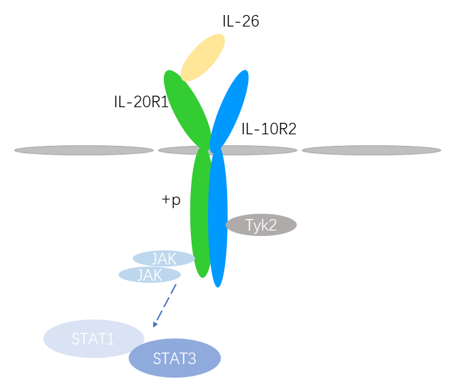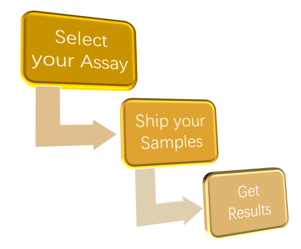Introduction
IL-26, a member of the IL-10 family produced by memory T cells, monocytes, and NK cells, is expressed at low levels in normal humans. But it is overexpressed in HSV-transformed human T cells, and in rheumatoid arthritis patients, IL-26 is produced primarily by synovial cells. It is highly expressed in the skin, testes, pancreas, heart, placenta, salivary glands, and prostate, but is expressed at low levels in the kidneys, liver, colon, and small intestine. It plays a pro-inflammatory role in rheumatoid arthritis and a role in antitumorigenesis.
Mechanism and Function
The active receptor complex of IL-26 is a dimer composed of IL-20R1 and IL-10R2, both class II cytokine receptors, with IL-20R1 expressed mainly in non-hematopoietic cells, especially epithelial cells, but not in lymphocytes, whereas IL-10R2 is widely expressed in various tissues. IL-20R1 is the main ligand-binding chain, which associates with Jak1, and the ligand checkpoint causes the initiation of a signal transduction cascade. il-10r2 associates with tyrosine protein kinase 2 (Tyk2), and the receptor-associated Jaks cross-activate and phosphorylate IL-20R1 intracellular domain, which activates STAT1 and STAT3.
IL-26 belongs to the IL-10 family and is structurally similar to IL-10, but it exhibits strong inflammatory effects in a variety of different tissues in the body, including the skin. It has been associated with inflammatory bowel disease and can participate in processes that regulate inflammation and immune responses. In addition, it shares a common genetic polymorphism with the IFN-γ gene and has a gender-based disease susceptibility to rheumatoid arthritis, so IL-26 plays a pro-inflammatory role in the pathogenesis of RA. IL-26 is also associated with psoriasis, where binding to its receptor IL-20R1 plays a strong pro-inflammatory role in the pathogenesis of psoriasis.
IL-26 also effectively promoted the recruitment of neutrophils to the focus of infection and exerted a bactericidal effect. With the participation of IL-26, the chemotactic effect of IL-8 on neutrophils is greatly enhanced. When viral infection occurs, IL-26 can activate natural killer (NK) cells to produce IL-1β, TNF-α and other pro-inflammatory factors to aggravate the inflammatory response of the liver. It was also able to promote the killing of HCV-infected Huh7.5 hepatocytes by upregulating tumor necrosis factor-associated apoptosis-inducing ligands on the surface of CD16+CD56brightNK cells.
 Fig 1. Mechanism of Signaling
Fig 1. Mechanism of Signaling
Creative Proteomics can provide cytokine detection platform for scientific research. According to different purposes, our dedicated analysts will customize exclusive solutions for you. We aim to provide customers with high-quality and convenient services to help you accelerate the progress of your project.
Our cytokine detection service includes but is not limited to:
- Quantitative and qualitative detection of cytokines in different species
- Quantitative and qualitative detection of cytokine antibodies
- Quantitative and qualitative detection of single/mulltiple cytokines
Sample requirements
- Sample Types-Blood, serum, plasma, cerebrospinal fluid, cell culture supernatant, tissue homogenate, cell culture medium, urine, tumor, etc.
- Sample Volume-It is optimal for at least 200µl of each sample. This volume allows for triplicate testing of each sample.
Our advantages:
- Efficient design: Multiplex reaction detecting in various methods are available, which can be selected according to different samples and requirements.
- Sensitive detection: High-quality antibodies are used in the detection process to improve detection specificity and accuracy.
- Reliable results: The feedback results are professional and efficient.
Technology platform:
We mainly provide the Luminex cytokine detection platform. Luminex uses fluorescently encoded microspheres with specific antibodies to different target molecules. The different microspheres can be combined freely to a certain extent so that up to 100 analytes can be tested multiple times simultaneously in a single experiment.
The Luminex cytokine assay platform has the following advantages:
- Multiple detection: simultaneous detection of 100 biological targets
- Short experiment time: 1-3 weeks
- High sensitivity: the lower limit of accurate quantification is as low as 0.1 pg/mL
- Save samples: only need a sample volume as low as 25 μL
- Time saving: the experiment process only takes 4 hours
For your different needs, we can also provide the following detection methods:
- Enzyme-linked immunosorbent assay (ELISA)
- Flow cytometry
Workflow

For more information about the IL-26 detection service or need other detection requirements, please contact us.
References:
- Sheikh F, Baurin V V, Lewisantes A, et al. Cutting Edge: IL-26 Signals through a Novel Receptor Complex Composed of IL-20 Receptor 1 and IL-10 Receptor 2. Journal of Immunology, 2004, 172(4):2006-2010.
- Hirsh J, Kositangool P, Shah A, et al. IL-26 mediated human cell activation and antimicrobial activity against Borrelia burgdorferi. Current Research in Microbial ences, 2020, 1:30-36.



